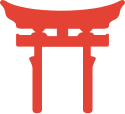Shinto music
| Part of a series on |
| Shinto |
|---|
 |
| Beliefs |
| Notable Kami |
| Important literature |
|
| Shinto shrines |
| Practices |
| See also |
Shinto music is the ceremonial and festive music of Shinto (神道), the indigenous religion of Japan. Its origin myth is the erotic dance of Ame-no-Uzume-no-Mikoto which lured Amaterasu from her cave.[1]
Kagura[]

Kagura (神楽) or 'entertainment of the gods' includes music, dance and poetry and comprises mi-kagura of the court, o-kagura of major shrines such as Ise Jingū, and village sato-kagura.[2]
Forms[]
The repertoire includes eight forms that may be traced back to the eighth century: kagura-uta (kagura songs), azuma asobi (eastern entertainment), kume-uta (palace guard songs) ō-uta (big songs), onaibi-uta (night duty songs), ruika (funeral songs), ta-uta (field songs), and yamato-uta (Yamato songs).[2]
Instruments[]
Instruments include the wagon (和琴), kagura-bue (神楽笛), hichiriki (篳篥), suzu (鈴), tsuzumi (鼓), and shakubyōshi (笏拍子) clappers. In local festivals the kane (鉦), binzasara (編木), and taiko (太鼓) may also be found.[2]
See also[]
References[]
- ^ Sadie, Stanley (ed.) (2001). The New Grove Dictionary of Music and Musicians XII.850f. Oxford University Press. ISBN 978-0-19-517067-2.CS1 maint: extra text: authors list (link)
- ^ Jump up to: a b c Malm, William P. (2000). Traditional Japanese Music and Musical Instruments. Kodansha. pp. 47–65. ISBN 4-7700-2395-2.
- Shinto
- Religious music
- Gagaku
- Shinto stubs
- Japan music stubs